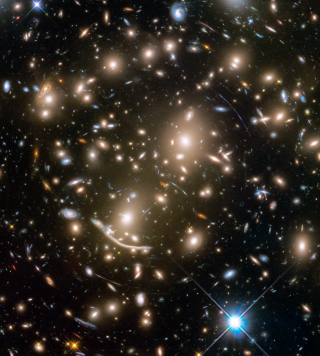Bibcode
Molaeinezhad, A.; Zhu, L.; Falcón-Barroso, J.; van de Ven, G.; Méndez-Abreu, J.; Balcells, M.; Aguerri, J. A. L.; Vazdekis, A.; Khosroshahi, H. G.; Peletier, R. F.
Referencia bibliográfica
Monthly Notices of the Royal Astronomical Society, Volume 488, Issue 1, p.1012-1025
Fecha de publicación:
9
2019
Número de citas
6
Número de citas referidas
5
Descripción
We construct Schwarzschild orbit-based models of NGC 7457, known as a
peculiar low-mass lenticular galaxy. Our best-fitting model successfully
retrieves most of the unusual kinematics behaviours of this galaxy, in
which, the orbital distribution of stars is dominated by warm and hot
orbits. The reconstructed surface brightness of the hot component
matches fairly well the photometric bulge and the reconstructed LOSVD
map of this component shows clear rotation around the major photometric
axis of the galaxy. In the absence of a dominant cold component, the
outer part of our model is dominated by warm orbits, representing an
exponential thick disc. Our orbital analysis also confirms the existence
of a counter-rotating orbital substructure in the very centre, reported
in previous observational studies. By comparing our model with a variety
of simulation studies, and considering the stellar kinematics and
populations properties of this galaxy, we suggest that the thick disc is
most likely a dynamically heated structure, formed through the
interactions and accretion of satellite(s) with near-polar initial
inclination. We also suggest a merger-driven process as the most
plausible scenario to explain the observed and dynamically modelled
properties of the bulge of NGC 7457. We conclude that both the high
level of cylindrical rotation and unusually low velocity dispersion
reported for the NGC 7457 have most likely external origins. Therefore,
NGC 7457 could be considered as a candidate for merger-driven
cylindrical rotation in the absence of a strong bar in disc galaxies.
Proyectos relacionados

Evolución de Galaxias en Cúmulos
Las estructuras en el Universo, a todas las escalas de masa, se han formado de una forma jerárquica y principalmente producidas por fusiones de galaxias. Sin embargo, esta formación jerárquica de las galaxias está modulada por el entorno en el cual se crean y evolucionan. Mientras que las galaxias de campo presentan una evolución pasiva, los
Jairo
Méndez Abreu

Huellas de la Formación de las Galaxias: Poblaciones estelares, Dinámica y Morfología
Bienvenida a la página web del g rupo de investigación Traces of Galaxy Formation. Somos un grupo de investigación amplio, diverso y muy activo cuyo objetivo principal es entender la formación de galaxias en el Universo de una manera lo más completa posible. Con el estudio detellado de las poblaciones estelares como bandera, estamos constantemente
Anna
Ferré Mateu

Huellas de la Formación de las Galaxias: Poblaciones estelares, Dinámica y Morfología
Bienvenida a la página web del g rupo de investigación Traces of Galaxy Formation. Somos un grupo de investigación amplio, diverso y muy activo cuyo objetivo principal es entender la formación de galaxias en el Universo de una manera lo más completa posible. Con el estudio detellado de las poblaciones estelares como bandera, estamos constantemente
Anna
Ferré Mateu